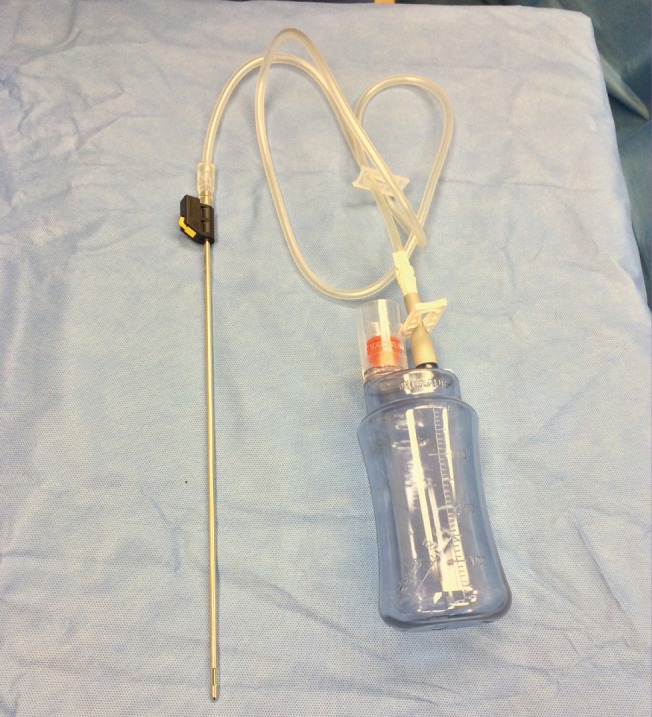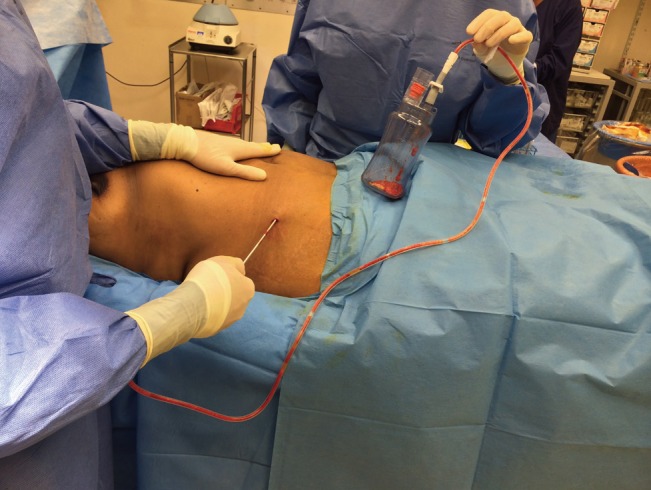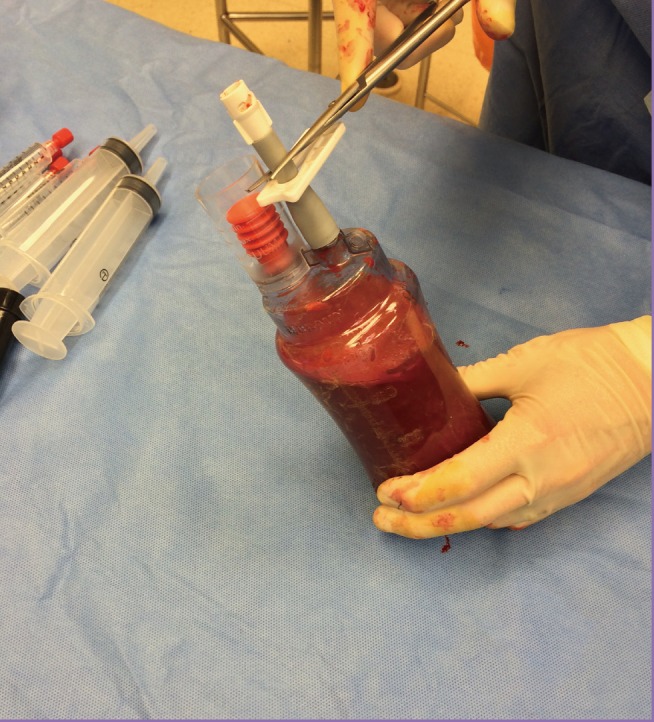Fat Harvest Using a Closed-Suction Drain
Article information
Abstract
We propose a safe, simple, and novel method to harvest fat using a standard liposuction cannula and a Redivac or alternative closed-suction drain. The authors have used this technique for both 'dry' and 'wet' liposuction. This technique is both easy to perform and cost-effective whilst providing both a silent and relatively atraumatic fat harvest. The lower negative pressure compared with traditional harvesting systems likely preserves fat integrity for lipofilling. This method maximises resources already held within a hospital environment.
INTRODUCTION
Autologous fat transfer has increased in popularity over the past twenty years to address contour defects in all regions of the body. Autologous fat transfer has been performed since the 1890s, with the use of injectable grafts since the 1920s [1]. Adipose tissue is readily available, inexpensive, does not mount an active immune response, and can be harvested repeatedly [2]. With the expanding application of autologous fat transfer and the popularity of cosmetic lipofilling, there have been a multitude of attempts over recent years to refine techniques of fat retrieval and lipofilling, often using complex and costly equipment. Initial techniques based on blunt dissection were replaced in the 1970s with a method depending on the aspiration of fat with a vacuum suction pump. Illouz later developed 'wet' liposuction involving the use of tumescence to allow ease of aspiration of the fat [3]. This was further adapted by Klein and Lillis to enable liposuction to become commonplace as a day-case procedure performed under regional anaesthesia [2].
Suction-assisted liposuction requires the fragmentation and breakdown of fat cell walls. The fat is aspirated through a cannula into tubing and collected within a receptacle. The rate of aspiration is directly proportional to the diameter of the suction tubing and the vacuum pressure generated by the suction pump. Conversely, it is inversely proportional to the cannula and suction tubing length [4]. We propose a safe, simple, and novel method to harvest fat using a standard liposuction cannula and a Redivac (Atrium Medical, Hudson, NH, USA) or alternative closed suction drain (Jackson-Pratt, Cardinal health/Blake, Ethicon Inc., Somerville, NJ, USA). The authors have used this technique for both 'dry' and 'wet' liposuction.
IDEA
The suction drain is connected to standard tubing (16-gauge drain) (Fig. 1). An airtight seal between the cannula and drain tubing is vital. A 3 mm or 4 mm cannula is most effective. The vacuum must remain closed whilst the cannula is outside the cavity so the vacuum is not compromised. Whilst performing liposuction and when the cannula tip is in the body cavity, the vacuum is released and the suction from the drainage bottle aspirates fat into the bottle (Fig. 2). In the case of fat injection, the drain valve is cut at the end of the procedure (Fig. 3). A 50 mL syringe can be used to aspirate the fat and transfer it to smaller syringes for centrifugation.

Closed suction drainage system connected to harvesting cannula
Closed suction drainage system connected to harvesting cannula.

Harvest of fat whilst the drainage system is closed
Harvest of fat whilst the drainage system is closed. The system is silent and easily manageable.
DISCUSSION
On a practical level, we have found this method to be extremely simple to perform. The Redivac/suction drain is light and attaches effortlessly to the conventional liposuction cannula. The associated tubing during aspiration from the bottle connects to a standard 50 mL syringe and requires minimal exertion to extract the aspirate. In our experience, suction pressure does not reduce significantly with increased bottle filling, even towards maximum capacity, thus negating the need for continual bottle changes. The design of the bottle with its graduated markings allows ease of recording the volumes of fat harvested. Furthermore, this technique is silent, sparing the background noise from standard suction-assisted liposuction devices. Suction drains are readily available in most theatre settings, making this technique applicable to both the office and hospital environment. Moreover they are cost-effective and disposable.
A study comparing fat harvesting with a 10 mL syringe and a traditional pump at suction pressures of -350 mm Hg and -700 mm Hg revealed that cell yield with a pressure of -350 mm Hg was greater than that obtained at -700 mm Hg and significantly better than fat aspirated with a syringe. Therefore, it has been suggested that negative pressure is a factor that influences the quantity of stromal vascular fraction cells [5]. The suction produced by a Redivac drain is in the region of -300 mm Hg, very similar to the -350 mm Hg suction described as ideal for harvesting adipose tissue on cell yield of the stromal vascular fraction [6].
Our proposed technique is ideal for small- to medium-volume liposuction, such as for facial, buttock and minor breast augmentation. The Redivac tubing readily accommodates fat lobules aspirated using 3 and 4 mm cannulae, with a noticeably greater proportion remaining intact than with the use of a machine-driven vacuum. The lower negative pressure used in this method is more likely to yield a higher quantity of viable fat graft whilst also reducing trauma to surrounding tissues, and therefore, reducing bruising and deformity postoperatively [6]. There are no added complications with this technique when compared to those of standard liposuction, in our experience [7].
Of note, this technique requires some familiarity. Common pitfalls include loss of vacuum in the bottle from withdrawing the cannula outside of the body cavity. Loss of the vacuum occurs rapidly. This can easily be addressed in the Redivac drain whereby the bottle vacuum can be reinstated by using a Yankauer suction tube whilst the clinician holds the suction device against the white plastic attachment of the vacuum bottle as described by Durai and Ng [8].
This useful tip is a representation of how innovation can enable maximal use of existing resources in the hospital environment.
Notes
No potential conflict of interest relevant to this article was reported.
